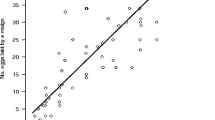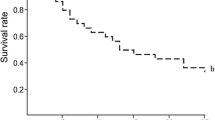Abstract
Clutch size decisions by Aphaereta minuta (Nees) (Hymenoptera: Braconidae), a polyphagous, gregarious, larval-pupal endoparasitoid, were studied under laboratory conditions. This parasitoid attacks larvae of Diptera inhabiting ephemeral microhabitats such as decaying plant and animal material. Females oviposit in young larval stages, but the eventual size of the host pupa determines host food availability for competing offspring. The size of the pupa can differ greatly between host species. We questioned how A. minuta females deal with this delay between the moment of oviposition and eventual host food availability, and whether they make clutch size decisions that benefit their fitness. It was shown that females indeed vary their clutch size considerably and in an adaptive way: (1) females lay larger clutches in larvae of host species that produce larger pupae, even when the larvae are the same size at the moment of oviposition, and (2) females lay larger clutches in larger larvae than in smaller larvae of the same host species. The latter seems functional as larvae parasitized at an older stage indeed developed into larger pupae compared to larvae parasitized at a younger stage. Furthermore, mortality of parasitized young host larvae was greater than that of both unparasitized larvae and parasitized older larvae. Under field conditions the risk of mortality of young host larvae is expected to be even higher due to the limited period of microhabitat (host food) availability, strong scramble type competition between the host larvae, and the longer period of being exposed to predation.
Similar content being viewed by others
References
Beckage NE, Riddiford LM (1983) Growth and development of the endoparasitic wasp Apanteles congregatus: dependence on host nutritional status and parasite load. Physiol Entomol 18: 231–241
Cymborowski B (1992) Insect endocrinology Elsevier, Amsterdam
Dijkstra LJ (1986) Optimal selection and exploitation of hosts in the parasitic wasp Colpoclypeus florus (Hymenoptera: Eulophidae). Neth J Zool 36: 177–301
Evans AC (1933) Comparative observations on the morphology and biology of some hymenopterous parasites of carrion-infesting Diptera. Bull Entomol Res 24: 385–405
Godfray HCJ (1987) The evolution of clutch size in invertebrates. In: Harvey PH, Partridge L (eds) Oxford Surveys in Evolutionary Biology. Oxford University Press, Oxford, pp 117–154
Godfray HCJ, Partridge L, Harvey PH (1991) Clutch size. Annu Rev Ecol Syst 22: 409–429
Hardy ICW, Griffiths NT, Godfray HCJ (1992) Clutch size in a parasitoid wasp: a manipulation experiment. J Anim Ecol 61: 121–129
Houser EC, Wingo CW (1967) Aphaereta pallipes as a parasite of the face fly in Missouri, with notes on laboratory culture and biology. J Econ Entomol 60: 731–733
Klomp H, Teerink BJ (1962) The significance of oviposition rate in the egg parasite Trichogramma embryophagum Htg. Arch Neerl Zool 17: 350–375
Lenteren JC van (1981) Host discrimination by parasitoids. In: Nordlund DA, Jones RL, Lewis WJ (eds) Semiochemicals. Wiley, New York, pp 153–179
Luck RF, Podoler H, Kfir R (1982) Host selection and egg allocation behaviour by Aphytis melinus and A. lingnanensis: A comparison of two facultatively gregarious parasitoids. Ecol Entomol 7: 397–408
Masurier AD le (1987) A comparative study of the relationship between host size and brood size in Apanteles spp. (Hymenoptera: Braconidae). Ecol Entomol 12: 383–393
Neser S (1973) Biology and behaviour of Euplectrus near laphygmae Ferriere (Hymenoptera: Eulophidae). Entomol Mem Dept Agric Tech Serv S Afr 32: 1–31
Salkeld EH (1959) Notes on anatomy, life-history, and behaviour of Aphaereta pallipes (Say) (Hymenoptera: Braconidae), a parasite of the onion maggot, Hylemia antiqua (Meig.). Can Entomol 91: 93–97
Salt GC (1961) Competition between insect parasites. Symp Soc Exp Biol 15: 96–119
Sato Y, Tanaka T (1984) Effect of the number of parasitoid wasp eggs (Apanteles kariyai) (Hymenoptera: Braconidae) on the growth of the host (Leucania separata) larvae (Lepidoptera: Noctuidae). Entomophaga 29: 21–28
Sato Y, Tagawa J, Hidaka T (1986) Effects of the gregarious parasitoids, Apanteles rufricus and A. kariyai, on host growth and development. J Insect Physiol 32: 281–286
Schmidt JM, Smith JJB (1985) Host volume measurement by the parasitoid wasp Trichogramma minutum: the roles of curvature and surface area. Entomol Exp Appl 39: 213–221
Slansky F (1986) Nutritional ecology of endoparasitic insects and their hosts: an overview. J Insect Physiol 32: 255–261
Sokal RR, Rohlf FJ (1981) Biometry, 2nd edn. Freeman, San Francisco
Sychevskaya VI (1964) Hymenopterous parasites of synanthropic flies in Soviet Central Asia. Entomol Rev 43: 199–206
Takagi M (1986) The reproductive strategy of the gregarious parasitoid, Pteromalus puparium (Hymenoptera: Pteromalidae). 2. Host size discrimination and regulation of the number and sex ratio of progeny in a single host. Oecologia 70: 321–325
Vet LEM, Alphen JJM van (1985) A comparative functional approach to the host detection behaviour of parasitic wasps. 1. A qualitative study on Eucoilidae and Alysiinae. Oikos 44: 478–486
Wylie HG (1967) Some effects of host size on Nasonia vitripennis and Muscidiforax raptor (Hymenoptera: Pteromalidae). Can Entomol 99: 742–748
Zinov'eva KB (1974) Stimulation of pupation of larvae of Calliphora vicina R.-D. (Diptera, Calliphoridae) by the parasite Aphaereta minuta Nees (Hymenoptera, Braconidae). Dokl Akad Nauk SSSR 216: 702–703
Author information
Authors and Affiliations
Rights and permissions
About this article
Cite this article
Vet, L.E.M., Datema, A., van Welzen, K. et al. Clutch size in a larval-pupal endoparasitoid. Oecologia 95, 410–415 (1993). https://doi.org/10.1007/BF00320996
Received:
Accepted:
Issue Date:
DOI: https://doi.org/10.1007/BF00320996




